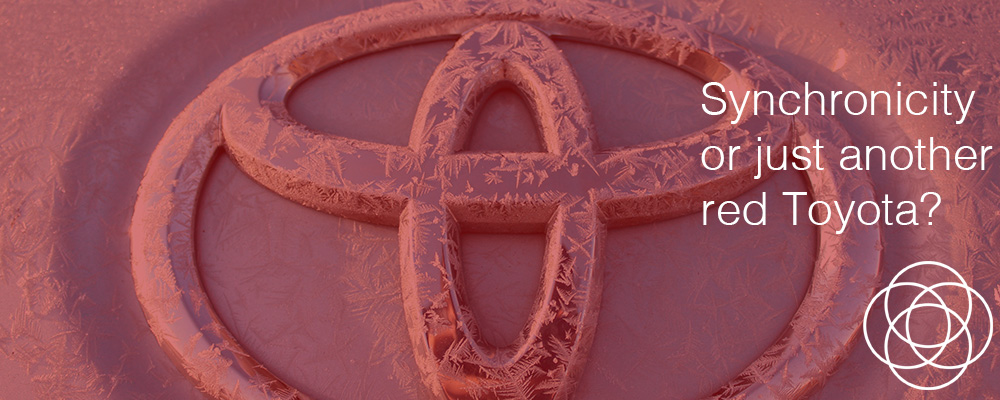A few weeks ago, I was listening to a podcast to get to know the host a little before being a guest on her show.
I clicked on her most recent episode, listened to some of it while doing some exercise at home, then settled into a window seat to hear the rest of the interview. I’ve forgotten what it was about, but I think they were comparing notes on business styles while wandering off into engaging personal asides. In any case, I needed a post-exercise rest, so I was content to gaze out the window and follow their conversation for the next little while.
I drifted in and out of listening, half contemplating some of the ideas they were sharing, going off on my own track, and half planning my day ahead, when my ears pricked up. I heard the word ‘synchronicity’, a subject dear to my heart. It wasn’t related to the topic of their chat, and I got the impression it arose spontaneously, so I was interested to hear what they had to say.
The guest mentioned the RAS, the Reticular Activating System, and the role it can play in precipitating experiences of synchronicity.
The Reticular Activating System is a network of nerves situated in the brain stem. It has many functions, including maintaining arousal and consciousness by activating the cerebral cortex, and regulating our sleep-wake cycles.
It also acts as a kind of filter, screening out things we don’t need to stay conscious of (like safe background noise) and alerting us to things we need to know or are interested in.
It’s the Reticular Activating System that will make you notice everyone’s shoes when you are on a mission to buy a new pair of shoes, or that will alert you to any mention of a subject that has particularly engaged you. Thank your RAS every time your ears prick up, or your eyes spot an item of interest that would otherwise be lost in a mountain of stuff.
I studied neurobiology at university, so this wasn’t new to me, but I was interested in how the conversation would evolve because I am familiar with the standard argument that synchronicity is really just a result of the RAS in action.
So, the guest painted an example. He made the point that if you develop a sudden interest in red Toyotas, you’ll begin to see red Toyotas everywhere. You will be overwhelmed by the number of red Toyotas you see in a short space of time, and you will conclude that these sightings are deeply meaningful synchronicities, perhaps bearing a message for you. You will overlook, he said, the fact that red Toyotas are extremely common vehicles.
His example is spot on. That is indeed how the RAS works, and it goes some way to explaining some experiences of synchronicity. But not all.
This is how the few seconds the guest spent outlining his example worked out for me, sitting in my window seat.
The moment he mentioned red Toyota, I looked out the window and saw a flashy new-looking red Toyota drive super-slowly past our house, as if it were looking for a parking spot. It stopped, even though there were no parking spots available. It then slowly coasted around the central bank of trees in the middle of the street, returned for another loop, and sped off down a perpendicular road. I watched it recede into the distance.
There was no other traffic movement during this time. The whole event played out while the podcast guest was talking about red Toyotas. Not before, not after, but simultaneously.
Later that day, I went for a walk down our street. There were maybe some thirty or forty cars parked, and only one of these was a red Toyota. It wasn’t the flashy new one that made such a song and dance for me earlier in the day.
Knowing what you know about the Reticular Activating System, what do you think of my synchronicity experience?
Synchronicities always feel deeply meaningful, even when we can’t elucidate that meaning. It’s easy to work at synchronicity, to go for a walk alert for signs, signals, or messages, to seek deeper meaning in what can be simply a result of your very efficient RAS doing its job for you. Look instead to those synchronicities that seem to have an energy of their own, that present themselves in situations that are not easily explained by RAS filtering. Like my red Toyota.
If you’ve been following my work for a while, you’ll know that synchronicity fascinates me as much as dreams do, but I don’t seek out synchronicity. I let it happen, although I do generally practise awareness of myself and my surroundings.
When I was listening to the podcast, my RAS did its job perfectly, alerting me to the word ‘synchronicity’ when I had been drifting in my attention. That one is definitely down to my RAS. But the red Toyota? I don’t think so, do you?
My new book, Bird of Paradise – Taming the Unconscious to Bring Your Dreams to Fruition, explores synchronicity and dreams. It’s part whimsical memoir, so it’s studded with my own stories while offering ways for you to find your calling and navigate your life. Its official publication date is 19 May, but you can read about it here and get your copy (paperback or eBook) now.

